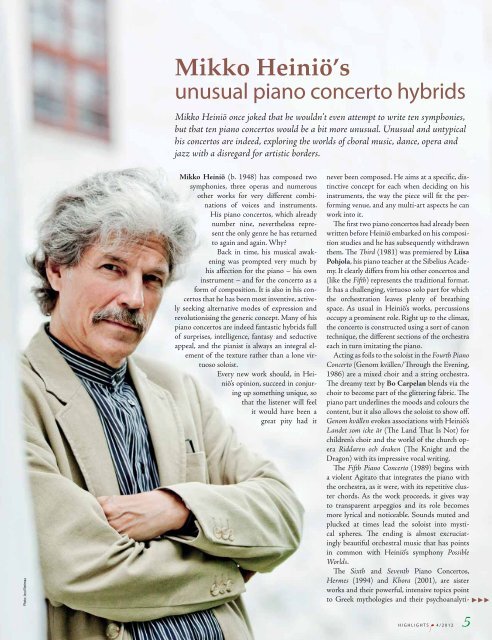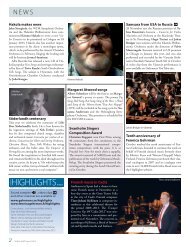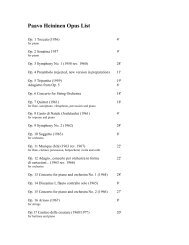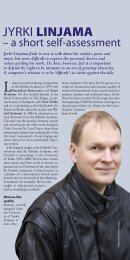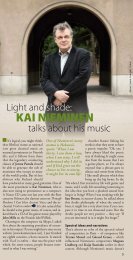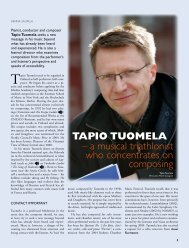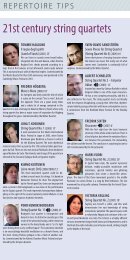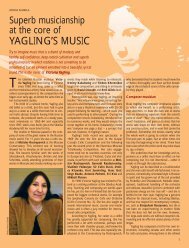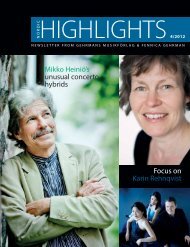Create successful ePaper yourself
Turn your PDF publications into a flip-book with our unique Google optimized e-Paper software.
Photo: Jussi Vierimaa<br />
<strong>Mikko</strong> Heiniö’s<br />
unusual piano concerto hybrids<br />
<strong>Mikko</strong> Heiniö once joked that he wouldn’t even attempt to write ten symphonies,<br />
but that ten piano concertos would be a bit more unusual. Unusual and untypical<br />
his concertos are indeed, exploring the worlds of choral music, dance, opera and<br />
jazz with a disregard for artistic borders.<br />
<strong>Mikko</strong> Heiniö (b. 1948) has composed two<br />
symphonies, three operas and numerous<br />
other works for very diff erent combinations<br />
of voices and instruments.<br />
His piano concertos, which already<br />
number nine, nevertheless represent<br />
the only genre he has returned<br />
to again and again. Why?<br />
Back in time, his musical awakening<br />
was prompted very much by<br />
his aff ection for the piano – his own<br />
instrument – and for the concerto as a<br />
form of composition. It is also in his concertos<br />
that he has been most inventive, actively<br />
seeking alternative modes of expression and<br />
revolutionising the generic concept. Many of his<br />
piano concertos are indeed fantastic hybrids full<br />
of surprises, intelligence, fantasy and seductive<br />
appeal, and the pianist is always an integral element<br />
of the texture rather than a lone virtuoso<br />
soloist.<br />
Every new work should, in Heiniö’s<br />
opinion, succeed in conjuring<br />
up something unique, so<br />
that the listener will feel<br />
it would have been a<br />
great pity had it<br />
never been composed. He aims at a specifi c, distinctive<br />
concept for each when deciding on his<br />
instruments, the way the piece will fi t the performing<br />
venue, and any multi-art aspects he can<br />
work into it.<br />
Th e fi rst two piano concertos had already been<br />
written before Heiniö embarked on his composition<br />
studies and he has subsequently withdrawn<br />
them. Th e Th ird (1981) was premiered by Liisa<br />
Pohjola, his piano teacher at the Sibelius Academy.<br />
It clearly diff ers from his other concertos and<br />
(like the Fifth) represents the traditional format.<br />
It has a challenging, virtuoso solo part for which<br />
the orchestration leaves plenty of breathing<br />
space. As usual in Heiniö’s works, percussions<br />
occupy a prominent role. Right up to the climax,<br />
the concerto is constructed using a sort of canon<br />
technique, the diff erent sections of the orchestra<br />
each in turn imitating the piano.<br />
Acting as foils to the soloist in the Fourth Piano<br />
Concerto (Genom kvällen/Th rough the Evening,<br />
1986) are a mixed choir and a string orchestra.<br />
Th e dreamy text by Bo Carpelan blends via the<br />
choir to become part of the glittering fabric. Th e<br />
piano part underlines the moods and colours the<br />
content, but it also allows the soloist to show off .<br />
Genom kvällen evokes associations with Heiniö’s<br />
Landet som icke är (Th e Land Th at Is Not) for<br />
children’s choir and the world of the church opera<br />
Riddaren och draken (Th e Knight and the<br />
Dragon) with its impressive vocal writing.<br />
Th e Fifth Piano Concerto (1989) begins with<br />
a violent Agitato that integrates the piano with<br />
the orchestra, as it were, with its repetitive cluster<br />
chords. As the work proceeds, it gives way<br />
to transparent arpeggios and its role becomes<br />
more lyrical and noticeable. Sounds muted and<br />
plucked at times lead the soloist into mystical<br />
spheres. Th e ending is almost excruciatingly<br />
beautiful orchestral music that has points<br />
in common with Heiniö’s symphony Possible<br />
Worlds.<br />
Th e Sixth and Seventh Piano Concertos,<br />
Hermes (1994) and Khora (2001), are sister<br />
works and their powerful, intensive topics point<br />
to Greek mythologies and their psychoanalyti- ▶▶▶<br />
HIGHLIGHTS 4/2012
▶▶▶<br />
cal interpretations. Heiniö composed them both<br />
as dance works and installations in close partnership<br />
with choreographer Tiina Lindfors.<br />
Hermes is scored for piano, soprano and string<br />
orchestra, while Khora has fi ve percussion players<br />
instead of an orchestra. Both concertos can<br />
also be performed in concert versions.<br />
Rhythm has always been an integral part of<br />
Heiniö’s music, and his passion for this can be<br />
traced back to the rock bands of his youth. Th e<br />
rhythmic beat springs both from the body and<br />
from various generic traditions, culminating in<br />
Khora, which also bears West African echoes.<br />
But then Heiniö did, after all, spend several<br />
periods at the Villa Karo in Benin, composing<br />
and learning how to drum. “Th e body’s expressive<br />
power, the performer’s transformation into<br />
a grand illusion, the intensity of the presence…<br />
Collaborating with Lindfors and the ERI Dance<br />
Th eatre, I seriously began to believe in the magic<br />
of music theatre,” he wrote.<br />
In the Kuukonsertto (Moon Concerto, 2008)<br />
commissioned by the Finnish Radio Symphony<br />
Orchestra, <strong>Mikko</strong> Heiniö once again sets off<br />
along a new path, and comes up with more surprises.<br />
Pairing the piano is a mezzo-soprano, and<br />
the music has an operatic feel and clear elements<br />
of Lied. Th ere are also some quotations from<br />
and variations on the song Kung Erik (King Eric)<br />
by Hugo Ingelius and John Dowland’s Galliard<br />
to Lachrimae for lute. According to Heiniö, the<br />
listener may not always be aware of these lyrical<br />
melodies, but the scent is nevertheless there.<br />
Th e Moon Concerto is a kindred work to Heiniö’s<br />
highly-acclaimed opera Eerik XIV (Erik XIV)<br />
and proceeds like a drama, as if from one scene<br />
to the next. Sometimes it is the piano’s job to<br />
comment on the singer, at others to carry the<br />
music along.<br />
Heiniö’s most recent concerto is once again a<br />
leap into new territory. Nonno for amplifi ed piano<br />
and big band (Piano Concerto No. 9, 2011)<br />
was a commission from the UMO Jazz Orchestra.<br />
At fi rst, Heiniö decided to give jazz a wide<br />
berth, even though there are some strong pointers<br />
to jazz in some of his earlier works, but in the<br />
end he got carried away by the characteristic big<br />
band sound. And this he successfully combines<br />
in Nonno with orchestration steeped in colour.<br />
<strong>Mikko</strong> Heiniö is already warming to the idea<br />
of writing a tenth piano concerto. It could be<br />
scored for piano, wind quintet and string quintet,<br />
but he is also toying with other options. One<br />
thing is, however, certain: it will once again be a<br />
new, exciting and unique addition to his series of<br />
piano concertos.<br />
Henna Salmela<br />
HIGHLIGHTS 4/2012


